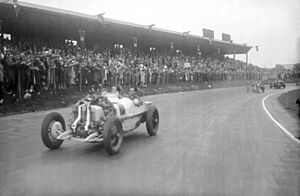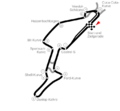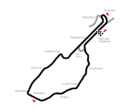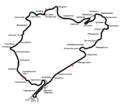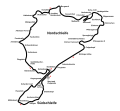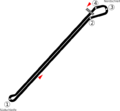German Grand Prix facts for kids
| Hockenheimring | |
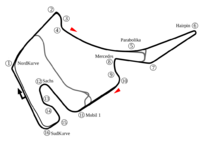 |
|
| Race information | |
|---|---|
| Number of times held | 78 |
| First held | 1926 |
| Last held | 2019 |
| Most wins (drivers) | |
| Most wins (constructors) | |
| Circuit length | 4.574 km (2.842 mi) |
| Race length | 306.458 km (190.424 mi) |
| Laps | 67 |
| Last race (2019) | |
| Pole position | |
|
|
| Podium | |
|
|
| Fastest lap | |
|
|
The German Grand Prix (in German: Großer Preis von Deutschland) was a famous car race held in Germany almost every year from 1926 to 2019. Over its long history, the race took place at three main tracks: the Nürburgring, the Hockenheimring, and sometimes the AVUS circuit in Berlin.
After World War II, West Germany was not allowed to join international sports right away. So, the German Grand Prix officially became part of the Formula One World Championship in 1951. It was a very important race, and four times it was also given the special title of the European Grand Prix.
From 1977 to 2006, the race was almost always at the Hockenheimring. For a while, Germany hosted two F1 races a year, with the Nürburgring hosting the European Grand Prix. Later, the two tracks took turns hosting the German Grand Prix. After 2014, Hockenheim hosted the race every other year until 2018, with one final race in 2019. Although Germany hosted the 2020 Eifel Grand Prix at the Nürburgring, a race called the German Grand Prix has not happened since 2019.
Contents
History of the Race
Early Races
The first major car race in Germany was the Kaiserpreis (Emperor's Prize) in 1907. It was held on public roads, which was very dangerous. During the race, a driver and his co-driver were killed in a crash. After this tragedy, the circuit was never used again.
In the 1920s, people realized that a special, permanent track was needed for racing. Inspired by tracks in Italy, Germany built the famous Nürburgring. This new track was designed to be a showcase for German cars and drivers.
Pre-War Grand Prix
The AVUS Track
The very first German Grand Prix was held in 1926 at the AVUS track in Berlin. The AVUS was a simple but very fast track, made of two long straight roads with a sharp turn at each end. German driver Rudolf Caracciola won the first race in the rain. However, the race was marred by a crash that killed three people, and the track was seen as too dangerous. The Grand Prix was moved to a new location.
The Legendary Nürburgring
The race moved to the new Nürburgring, a massive 28.3 km (17.6 mi) track in the Eifel Mountains. It was an incredibly difficult circuit that twisted through forests, with big hills and dips. Some parts of the track were so steep that cars would actually fly into the air for a moment.
The race was held on the full track until 1931, when it switched to using only the northern loop, the famous 22.8 km (14.2 mi) Nordschleife. This became the main layout for decades.
One of the most famous races happened in 1935. Italian driver Tazio Nuvolari was in an older, slower Alfa Romeo. He was competing against the powerful German "Silver Arrows" cars from Mercedes and Auto Union. Despite a bad start and a slow pit stop, Nuvolari drove brilliantly and caught the leader on the final lap to win. The crowd of 350,000 people was stunned.
Racing continued at the Nürburgring until World War II began in 1939, which stopped all international racing.
After World War II
Return to the Nürburgring

After the war, the German Grand Prix returned and joined the new Formula One World Championship in 1951. The Nürburgring Nordschleife became known as the toughest track in F1. Drivers nicknamed it "The Green Hell" because it was so long, difficult, and dangerous.
The great Argentine driver Juan Manuel Fangio had one of his most famous victories here in 1957. After a slow pit stop left him almost a minute behind the leaders, he drove faster than ever before. He broke the lap record nine times and passed both leaders on the second-to-last lap to win the race and his fifth world championship.
However, the track was also the site of many tragedies. Over the years, several drivers were killed in accidents, including Onofre Marimón in 1954 and Peter Collins in 1958. The track was simply too dangerous for the increasingly fast F1 cars.
The End of an Era
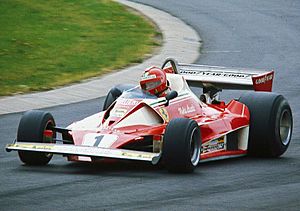
By the 1970s, drivers began to demand safer tracks. The Nürburgring was over 22 km long, making it almost impossible to have enough safety marshals and medical staff everywhere. In 1970, the drivers boycotted the race, forcing it to move to the Hockenheimring for a year.
The Nürburgring was updated with safety barriers, but it was still very dangerous. The final F1 race on the Nordschleife was in 1976. During that race, reigning world champion Niki Lauda had a terrible crash. His car burst into flames, and he was bravely pulled from the fire by other drivers.
Lauda survived his injuries, but the accident proved that the track was too unsafe for Formula One. The German Grand Prix left the Nordschleife for good.
The Hockenheim Era
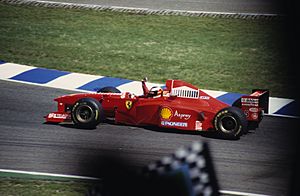
For the next 30 years, the German Grand Prix was held at the Hockenheimring. This was a very different track, known for its long, fast straights that cut through a forest. Over the years, chicanes (slow corners) were added to make the track safer.
In the 1990s, the popularity of Formula One in Germany exploded thanks to Michael Schumacher. In 1995, he became the first German driver to win his home race since 1939. He would go on to win it three more times.
In 2002, the Hockenheimring was completely redesigned. The long forest straights were removed, and the track was made shorter and more modern.
Alternating Tracks and Final Races
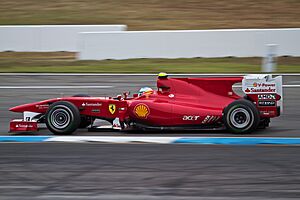
In 2007, a new plan was made to have the German Grand Prix switch between the Hockenheimring and the new, shorter Nürburgring Grand Prix circuit. This continued until 2013.
After 2013, the Nürburgring had financial problems and could no longer host the race. The German Grand Prix was only held at Hockenheim in 2014, 2016, and 2018. A final race was held at Hockenheim in 2019, which was won by Max Verstappen in very wet and chaotic conditions. Since then, the German Grand Prix has not been on the Formula One calendar.
Images for kids
-
Bernd Rosemeyer racing an Auto Union in 1937. He finished third.
-
In 1962, Graham Hill won the race on his way to the World Championship.
-
Jackie Stewart in a Matra MS10 on his way to a dominant victory in 1968.
-
Emerson Fittipaldi in 1971, the year the race returned to the modified Nürburgring.
-
Michele Alboreto took victory at the one-off return to the new Nürburgring in 1985.
See also
 In Spanish: Gran Premio de Alemania para niños
In Spanish: Gran Premio de Alemania para niños


